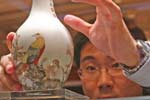Specials
The way of the fist
Updated: 2011-01-21 07:34
By Yan Yiqi (China Daily)
|
Shaolin Temple Abbot Shi Yongxin holds a ritual at a temple in Kunming. Zhang Yongqiang / for China Daily |
Shaolin Temple charts aggressive expansion plan to cash in on growing demand for kungfu. Yan Yiqi reports.
Winds of change are sweeping through the famed Shaolin Temple in central China's Henan province. The cradle of Chinese kungfu plans to spread its wings across the globe more aggressively not only to increase its influence, but also to bring about a semblance of order in the way it runs its overseas cultural centers.
Shi Yongxin, the temple's abbot and first Chinese monk to get a master's degree in business administration, said the expansion plan was not aimed at making money, but to promote the legendary Shaolin culture in the West.
"If the temple makes larger differences abroad, it will have a broader influence in China," Shi said at an international forum in Beijing recently. It has an international footprint of 40 centers spanning cities like London, Berlin and Rome. Plans are also afoot to set up centers in Paris and Amsterdam.
According to Shi, the overseas centers, which provide martial arts training, workshops on Zen meditation and Chinese language courses, have evoked a good response. "The student intake at our US cultural centers has exceeded 400,000 and most of them have traveled to China for further communication with our monks."
Promoting Shaolin culture in languages like English, Spanish and German are top of Shi's agenda and the abbot is leaving no stone unturned to provide the requisite training for his monks. Shi wants his monks to possess communication and teaching skills in at least one foreign language before they go abroad.
Though the temple's overseas expansion plan has found favor with the local government and enterprises, it has also evoked sharp criticism from some quarters. According to recent media reports, the temple holds control of some 40 overseas companies.
Dismissing these charges as baseless, Qin Daliang, manager of the Shaolin Intangible Assets Management Center says in his official blog that, "the overseas centers are not companies, but charity organizations." The overseas centers were initially the rented facilities used by the monks. The tuition fees and donations received from adherents were subsequently used to acquire the premises.
"Chinese kungfu culture, represented by the Shaolin Temple, has a universal appeal. The centers were established to satisfy kungfu fans' demands for more direct cultural contacts," Qian says.
According to Shi, the expansion plan makes sense especially as the demand for Shaolin kungfu centers is growing in the West. "Additionally there are also no expenses involved for the temple," he says. While the average number of students at a typical overseas Shaolin center is around 100, some centers have the facilities to increase the intake to over 1,000, Shi says.
In Germany, the Shaolin Temple has a main cultural center in Berlin, and a branch in Biederfeld. The Berlin center, spread over an area of over 3,000 square meters, currently has over 500 students and several thousand alumni, says Ding Ding, the monk who looks after the temple's European cultural centers. The Berlin center has four Shaolin monks, including the abbot Shi Yongchuan, a 33rd generation Shaolin disciple. The center teaches courses like kungfu, qigong (Chinese breathing exercise), tai chi and Zen meditation.
Ding says the ages of the students at the Berlin center vary from 4 to 80. Most of them are between 14 and 25 and include not only local residents but also students from abroad. "Those who do not live in the country come to our centers to study Shaolin kungfu during the winter and summer breaks," Ding says.
"Young people come to us because they want to learn authentic Shaolin kungfu, while the middle-aged and senior citizens focus more on healthcare courses like qigong and tai chi," Ding says, adding that women in Europe are also interested in learning kungfu. The tuition fees range from 30 to 100 euros ($40-134) a month for adults and 20 to 75 euros a month for children under 16.
The centers also conduct study tours every year to China for foreign disciples to experience the life of a Shaolin disciple. "The tours usually last for two to three weeks, and the foreign students will eat and live like the monks in the temple. The tours will help them understand more about Shaolin culture than just kungfu," Ding says.
The growing popularity of the overseas centers has also put the temple in a spot as there are several pretenders. Ding says that only the Berlin, Biederfeld, London and Rome centers are directly managed by the temple and have Shaolin monks as instructors. There are, however, several kungfu training centers set up by locals that claim to be branches of the Shaolin Temple.
Ding says the temple decided to authorize some of the centers and sent monks to train them in Shaolin culture. Last year, the temple also established a Shaolin Europe Association in Berlin to better supervise the promotion of Shaolin culture.
Ding says that the presence of copycats will ruin the rich legacy of the Shaolin Temple.
"There is no unification of those centers yet. Some of the organizers just came to China and studied kungfu for two or three months, and opened a training center back home," he says.
"That is not good for the promotion of authentic Shaolin culture, because kungfu is not the only thing Shaolin carries. There is also several thousand years of culture within."
"Going out to foreign countries is not a problem for our monks, as they always lead wandering lives," Shi, the abbot, says. "It is a traditional way of practicing Buddhism. I hope other temples in China also send their monks abroad as it is an ideal way to promote Buddhism globally."
E-paper

Green light
F1 sponsors expect lucrative returns from Shanghai pit stop
Buying into the romance
Born to fly
Light of hope
Specials

Share your China stories!
Foreign readers are invited to share your China stories.

No more Mr. Bad Guy
Italian actor plans to smash ‘foreign devil’ myth and become the first white kungfu star made in China.

Art auctions
China accounted for 33% of global fine art sales.

